FISCO BCOS 搭建区块链,在SpringBoot中调用合约
Posted 不凉帅
tags:
篇首语:本文由小常识网(cha138.com)小编为大家整理,主要介绍了FISCO BCOS 搭建区块链,在SpringBoot中调用合约相关的知识,希望对你有一定的参考价值。
一、搭建区块链
使用的是FISCO BCOS 和 WeBASE-Front来搭建区块链,详细教程:
https://blog.csdn.net/yueyue763184/article/details/128924144?spm=1001.2014.3001.5501
搭建好能达到下图效果即可:

二、部署智能合约与导出java文件、SDK证书下载
1.创建测试用户,导出pem文件
点击“测试用户”,即可“新增用户”。
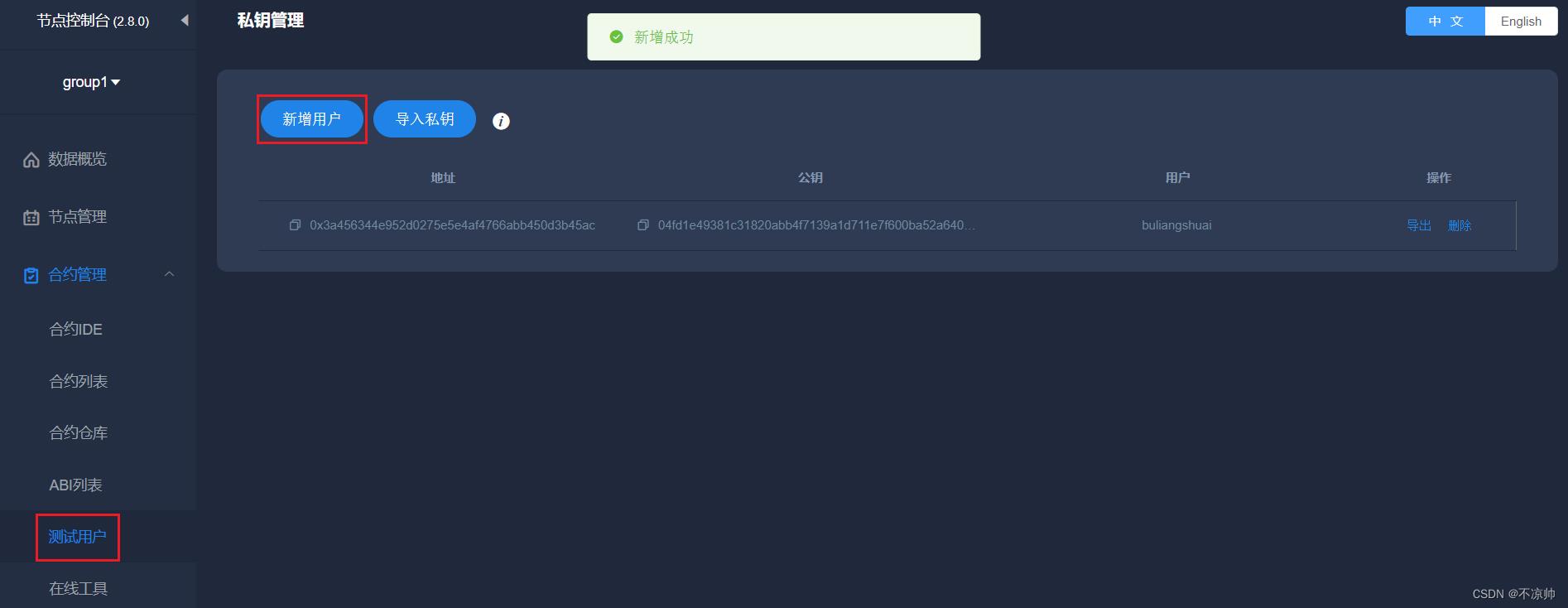
点击“导出”,选择.pem文件。
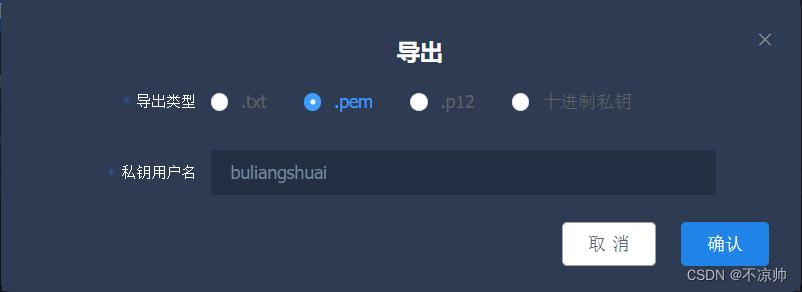
2.编译部署智能合约,导出java文件和SDK证书下载
在“合约IDE”中准备智能合约,新建合约文件,合约名称是Asset。
pragma solidity ^0.4.25;
contract Asset
address public issuer;
mapping (address => uint) public balances;
event Sent(address from, address to, uint amount);
constructor()
issuer = msg.sender;
function issue(address receiver, uint amount) public
if (msg.sender != issuer) return;
balances[receiver] += amount;
function send(address receiver, uint amount) public
if (balances[msg.sender] < amount) return;
balances[msg.sender] -= amount;
balances[receiver] += amount;
emit Sent(msg.sender, receiver, amount);
合约IDE会自动保存的,点击“编译”、“部署”后即可得到合约地址contractAddress。
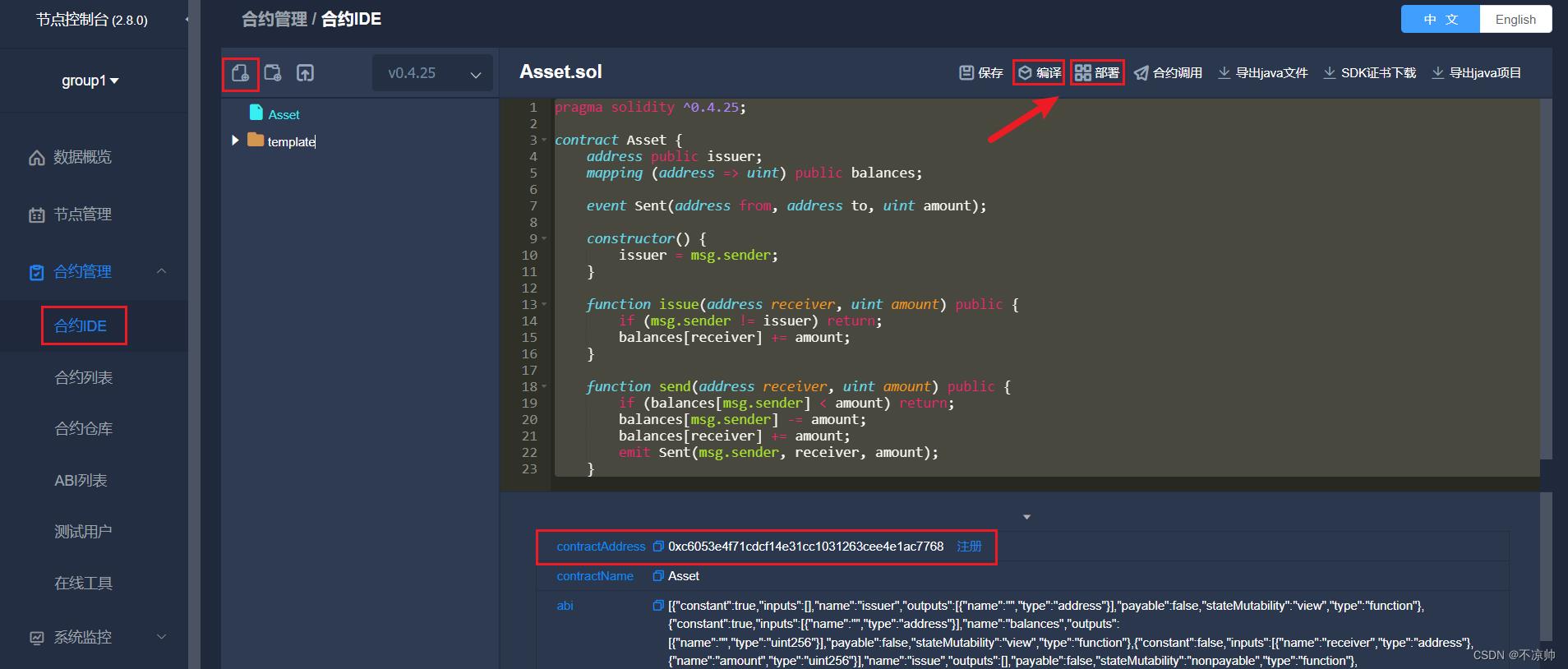
点击“导出java文件”,一般命名与合约名称相同为Asset;
点击“SDK证书下载”;
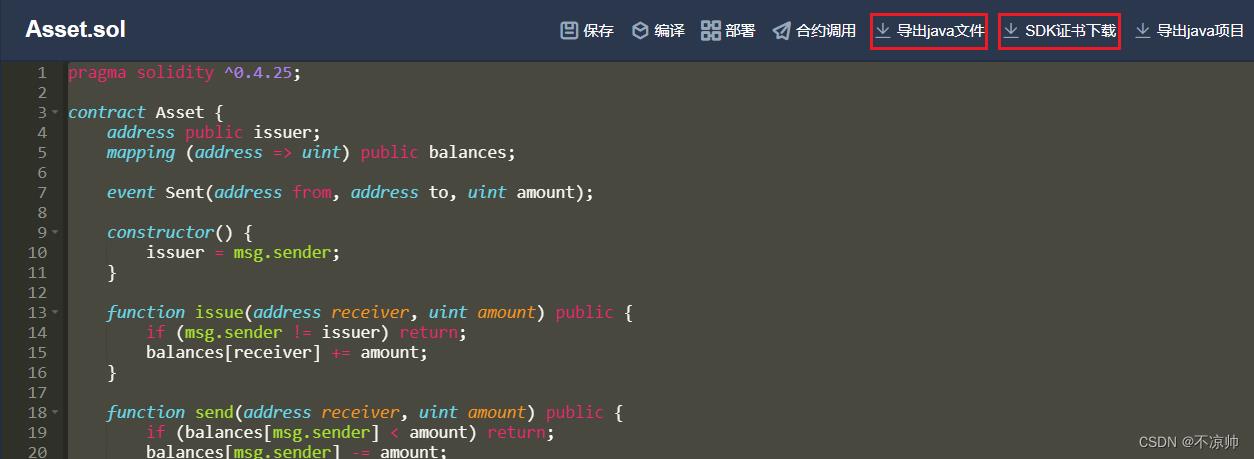
得到的文件如下:

三、在SpringBoot项目中调用智能合约
1.首先创建SpringBoot项目
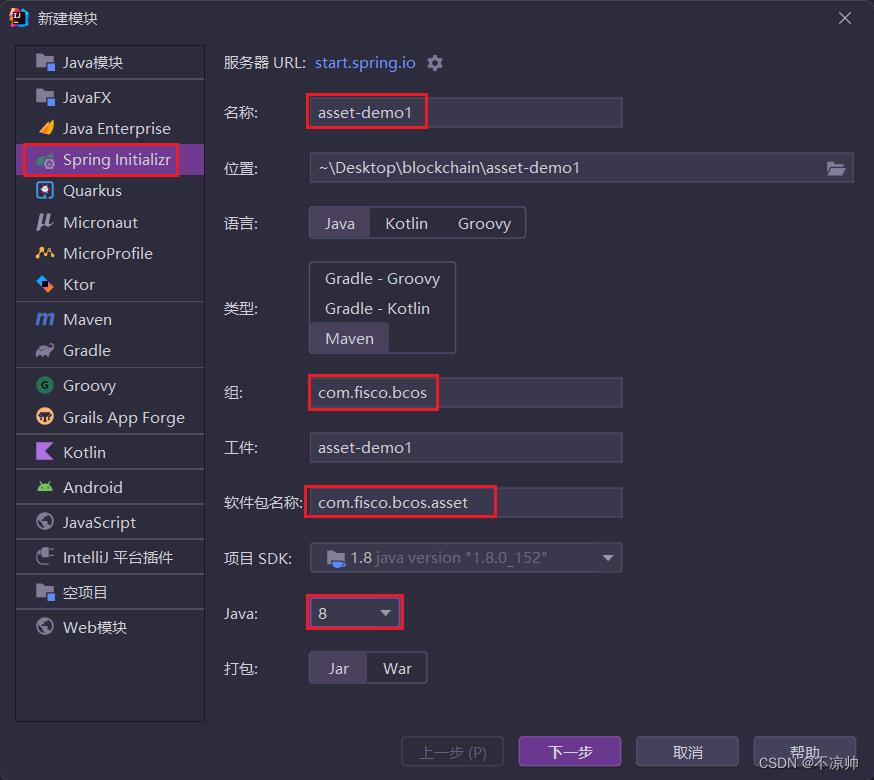
2.在pom文件中导入相关依赖
<!-- web -->
<dependency>
<groupId>org.springframework.boot</groupId>
<artifactId>spring-boot-starter-web</artifactId>
</dependency>
<!-- test -->
<dependency>
<groupId>org.springframework.boot</groupId>
<artifactId>spring-boot-starter-test</artifactId>
<scope>test</scope>
</dependency>
<!-- fisco bcos -->
<dependency>
<groupId>org.fisco-bcos.java-sdk</groupId>
<artifactId>fisco-bcos-java-sdk</artifactId>
<version>2.9.1</version>
</dependency>3.将下载的相关文件导入对应的文件目录(sdk要先解压)
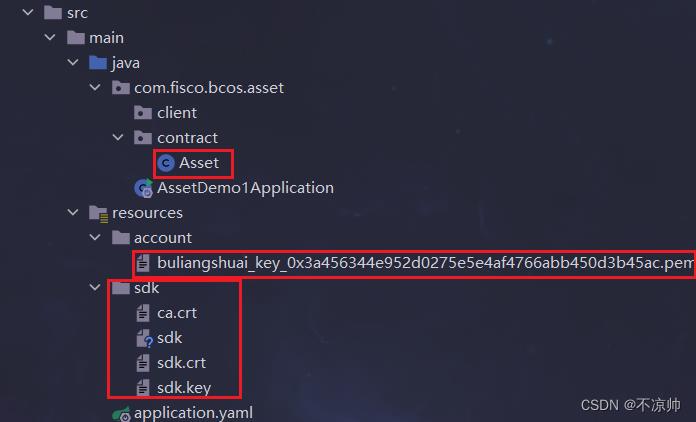
4.在application.yaml配置文件编写fisco的配置
注意:要将路径和合约地址换成自己的
fisco:
nodeList: 192.168.119.138:20201
groupId: 1
certPath: src\\main\\resources\\sdk
contractAddress:
# Asset合约地址(一定要加引号 不然注解@Value会把按照16进制数字进行转换赋值)
asset: "0xc6053e4f71cdcf14e31cc1031263cee4e1ac7768"
# 测试用户地址
account:
# 测试用户秘钥地址
accountAddress: src\\main\\resources\\account
# 测试用户文件地址
accountFilePath: src\\main\\resources\\account\\buliangshuai_key_0x3a456344e952d0275e5e4af4766abb450d3b45ac.pem
说明:
fisco.nodeList:区块链节点的ip和端口;
fisco.groupId:组ID;
fisco.certPath:证书保存目录;
fisco.contractAddress.asset:合约地址;
fisco.contractAddress.account.accountAddress:测试用户地址;
fisco.contractAddress.account.accountFilePath:测试用户的pem文件地址;
5.编写sdk访问合约方法
在client包中创建2个类,一个是环境配置类ApplicationContext
package com.fisco.bcos.asset.client;
import org.fisco.bcos.sdk.BcosSDK;
import org.fisco.bcos.sdk.client.Client;
import org.fisco.bcos.sdk.config.ConfigOption;
import org.fisco.bcos.sdk.config.exceptions.ConfigException;
import org.fisco.bcos.sdk.config.model.ConfigProperty;
import org.fisco.bcos.sdk.crypto.CryptoSuite;
import org.fisco.bcos.sdk.crypto.keypair.CryptoKeyPair;
import org.springframework.beans.factory.annotation.Value;
import org.springframework.context.annotation.Bean;
import org.springframework.context.annotation.Configuration;
import java.util.Arrays;
import java.util.HashMap;
import java.util.List;
import java.util.Map;
/**
* @Description: 配置类
*/
@Configuration
public class ApplicationContext
@Value("$fisco.nodeList")
private String nodeLists;
@Value("$fisco.groupId")
private Integer groupId;
@Value("$fisco.certPath")
private String certPath;
@Value("$fisco.account.accountFilePath")
private String accountFilePath;
@Bean(name = "configProperty")
public ConfigProperty defaultConfigProperty()
ConfigProperty property = new ConfigProperty();
// 配置cryptoMaterial
Map<String, Object> cryptoMaterialMap = new HashMap<>();
cryptoMaterialMap.put("certPath", certPath);
property.setCryptoMaterial(cryptoMaterialMap);
// 配置network
Map<String, Object> networkMap = new HashMap<>();
String[] split = nodeLists.split(",");
List<String> nodeList = Arrays.asList(split);
networkMap.put("peers", nodeList);
property.setNetwork(networkMap);
// 配置account
Map<String, Object> accountMap = new HashMap<>();
accountMap.put("keyStoreDir", "account");
accountMap.put("accountAddress", "");
accountMap.put("accountFileFormat", "pem");
accountMap.put("password", "");
accountMap.put("accountFilePath", accountFilePath);
property.setAccount(accountMap);
//配置 threadPool
Map<String, Object> threadPoolMap = new HashMap<>();
threadPoolMap.put("channelProcessorThreadSize", "16");
threadPoolMap.put("receiptProcessorThreadSize", "16");
threadPoolMap.put("maxBlockingQueueSize", "102400");
property.setThreadPool(threadPoolMap);
return property;
@Bean(name = "configOption")
public ConfigOption defaultConfigOption(ConfigProperty configProperty) throws ConfigException
return new ConfigOption(configProperty);
@Bean(name = "bcosSDK")
public BcosSDK bcosSDK(ConfigOption configOption)
return new BcosSDK(configOption);
@Bean(name = "client")
public Client getClient(BcosSDK bcosSDK)
// 为群组初始化client
Client client = bcosSDK.getClient(groupId);
return client;
@Bean
public CryptoKeyPair getCryptoKeyPair(Client client)
// 如果有密钥文件 那么每次读取的就不再是随机的
CryptoSuite cryptoSuite = client.getCryptoSuite();
CryptoKeyPair cryptoKeyPair = cryptoSuite.getCryptoKeyPair();
return cryptoKeyPair;
另一个是合约客户端类AssetClient
package com.fisco.bcos.asset.client;
import com.fisco.bcos.asset.contract.Asset;
import org.fisco.bcos.sdk.BcosSDK;
import org.fisco.bcos.sdk.client.Client;
import org.fisco.bcos.sdk.crypto.keypair.CryptoKeyPair;
import org.fisco.bcos.sdk.model.TransactionReceipt;
import org.fisco.bcos.sdk.model.callback.TransactionCallback;
import org.springframework.beans.factory.annotation.Autowired;
import org.springframework.beans.factory.annotation.Value;
import org.springframework.stereotype.Component;
import java.math.BigInteger;
@Component
public class AssetClient
@Autowired
private BcosSDK bcosSDK;
@Autowired
private Client client;
@Autowired
private CryptoKeyPair cryptoKeyPair;
@Value("$fisco.contractAddress.asset")
private String contractAddress;
/**
* 发布资产(条件:当前用户是Asset合约发布者)
* @param receiver 接收者地址
* @param amount 资产数量
*/
public void issueAsset(String receiver, BigInteger amount)
Asset asset = Asset.load(contractAddress, client, cryptoKeyPair);
asset.issue(receiver, amount, new CallbackResponse());
/**
* 发送资产(条件:发送者的账号Balance必须大于等于amount)
* @param receiver 接收者地址
* @param amount 资产数量
*/
public void sendAsset(String receiver, BigInteger amount)
Asset asset = Asset.load(contractAddress, client, cryptoKeyPair);
asset.send(receiver, amount, new CallbackResponse());
private class CallbackResponse extends TransactionCallback
@Override
public void onResponse(TransactionReceipt transactionReceipt)
System.out.println("回调结果:");
System.out.println(transactionReceipt.getContractAddress());
System.out.println(transactionReceipt.getFrom());
System.out.println(transactionReceipt.getGasUsed());
System.out.println(transactionReceipt.getRemainGas());
System.out.println(transactionReceipt.getStatus());
System.out.println(transactionReceipt.getMessage());
System.out.println(transactionReceipt.getStatusMsg());
6.编写测试类调用智能合约函数
首先编写测试类AssetClientTest
package com.fisco.bcos.asset.client;
import com.fisco.bcos.asset.AssetDemo1Application;
import org.junit.Test;
import org.junit.runner.RunWith;
import org.springframework.beans.factory.annotation.Autowired;
import org.springframework.boot.test.context.SpringBootTest;
import org.springframework.test.context.junit4.SpringJUnit4ClassRunner;
import java.math.BigInteger;
@RunWith(SpringJUnit4ClassRunner.class)
@SpringBootTest(classes = AssetDemo1Application.class)
public class AssetClientTest
@Autowired
private AssetClient assetClient;
@Test
public void testIssueAsset() throws InterruptedException
String receiver = "0xc6053e4f71cdcf14e31cc1031263cee4e1ac7768";
BigInteger amount = new BigInteger("10000");
assetClient.issueAsset(receiver, amount);
Thread.sleep(5000);
System.out.println("发布成功!");
@Test
public void testSendAsset() throws InterruptedException
String receiver = "0xc6053e4f71cdcf14e31cc1031263cee4e1ac7768";
BigInteger amount = new BigInteger("50000");
assetClient.sendAsset(receiver, amount);
Thread.sleep(5000);
System.out.println("发送成功!");
测试的步骤:
1)先后执行testIssueAsset和testSendAsset测试方法,该测试要保证服务器的20200、20201端口是开放的,命令如下:
firewall-cmd --zone=public --add-port=20201/tcp --permanent # 开放端口
firewall-cmd --zone=public --remove-port=20201/tcp --permanent #关闭端口
firewall-cmd --reload # 配置立即生效
firewall-cmd --zone=public --list-ports # 查看防火墙所有开放的端口
2)执行成功后,在节点控制台的“合约列表”中找到对应的合约,点击“合约调用”,选择balances方法;
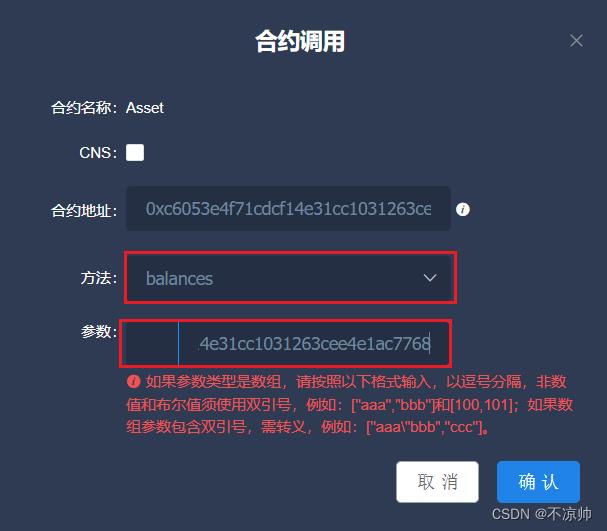
结果如下:

以上就是在Fisco区块链上部署智能合约,并通过Java SDK调用智能合约函数的示例.
FISCO BCOS搭建多机区块链网络
我使用两台虚拟机,IP地址分别是192.168.217.132,192.168.217.128,每台配置一个节点。
1.生成区块链网络配置文件
#根据自己的机器IP填写
cat >> ipconf << EOF
192.168.217.132 agencyA 1
192.168.217.128 agencyA 1
EOF
2.基于配置文件生成区块链节点配置
bash build_chain.sh -f ipconf -p 30300,20200,8545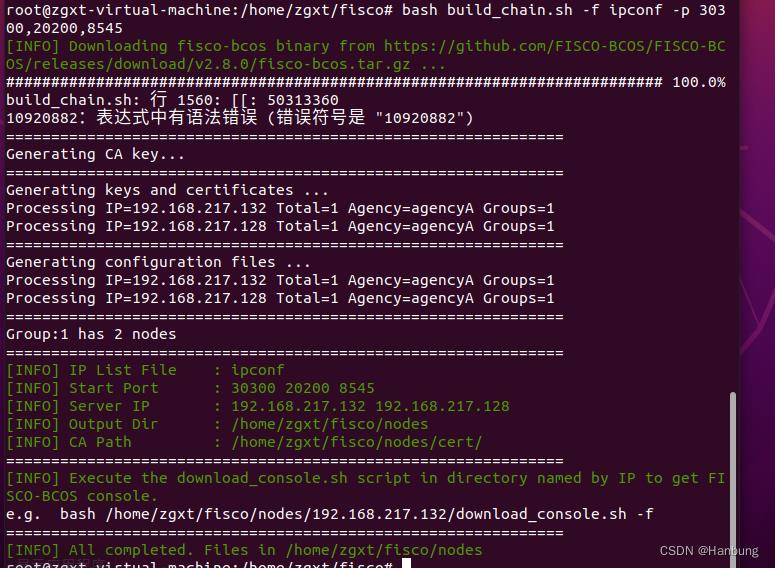
命令执行成功会输出All completed。如果执行出错,请检查nodes/build.log文件中的错误信息。
至此,成功生成了多机4节点配置,每台机器的区块链节点配置均位于nodes文件夹下,如下:

3.拷贝区块链节点配置
先为每台机器创建fisco目录
ssh fisco@196.168.0.1 "mkdir -p ~/fisco"

拷贝节点配置
ssh zgxt@192.168.217.128 "mkdir -p ~/fisco"
4.启动区块链节点
我使用192.168.217.132作为主机
bash nodes/192.168.217.132/start_all.sh
ssh zgxt@192.168.217.128 "bash ~/fisco/192.168.217.128/start_all.sh" 
5.检查区块链节点
检查进程是否启动成功
ps aux | grep -v grep | grep fisco-bcos正常情况,每台机器都会有类似下面的输出:

检查网络连接是否正常
tail -f 192.168.217.132/node0/log/* | grep -i connected检查区块链共识是否正常
tail -f 192.168.217.132/node0/log/* | grep -i +++
可以配置一下webase-front查看节点情况!
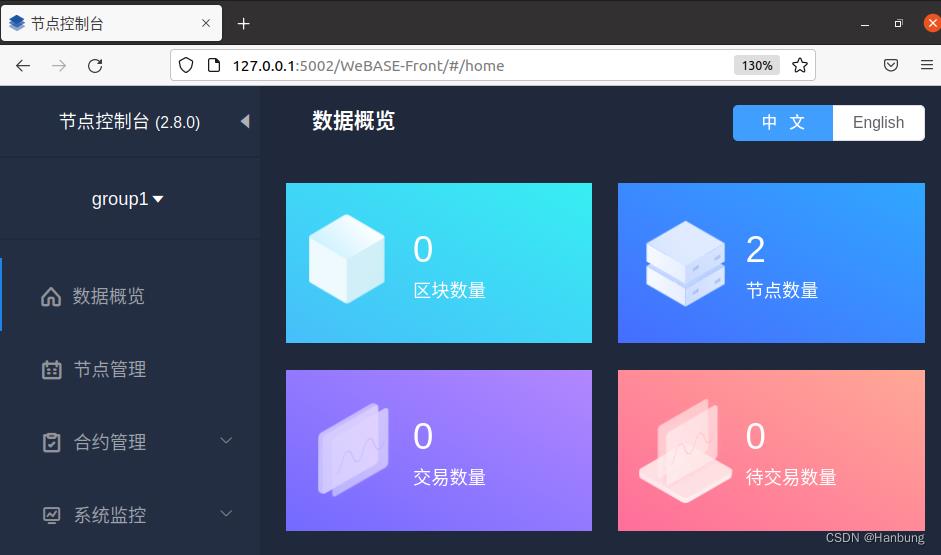
Well done!
以上是关于FISCO BCOS 搭建区块链,在SpringBoot中调用合约的主要内容,如果未能解决你的问题,请参考以下文章